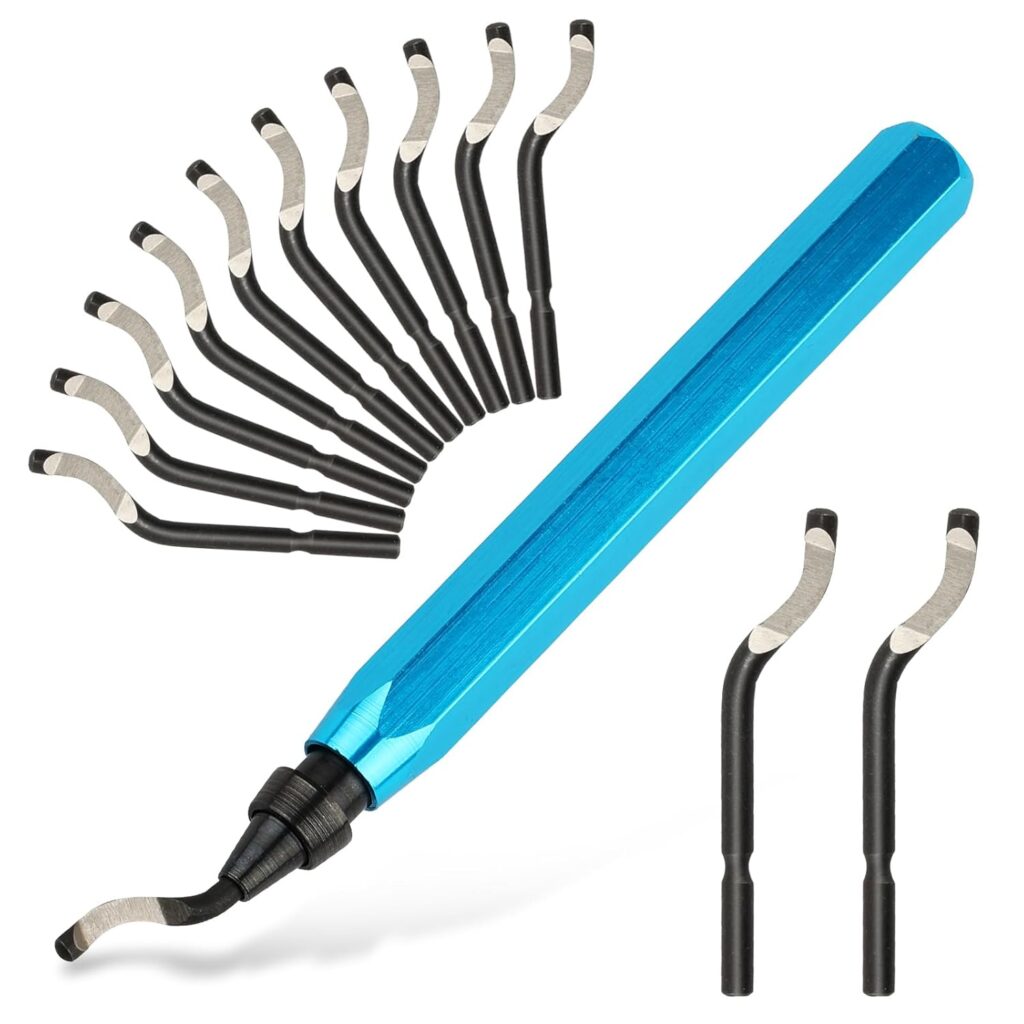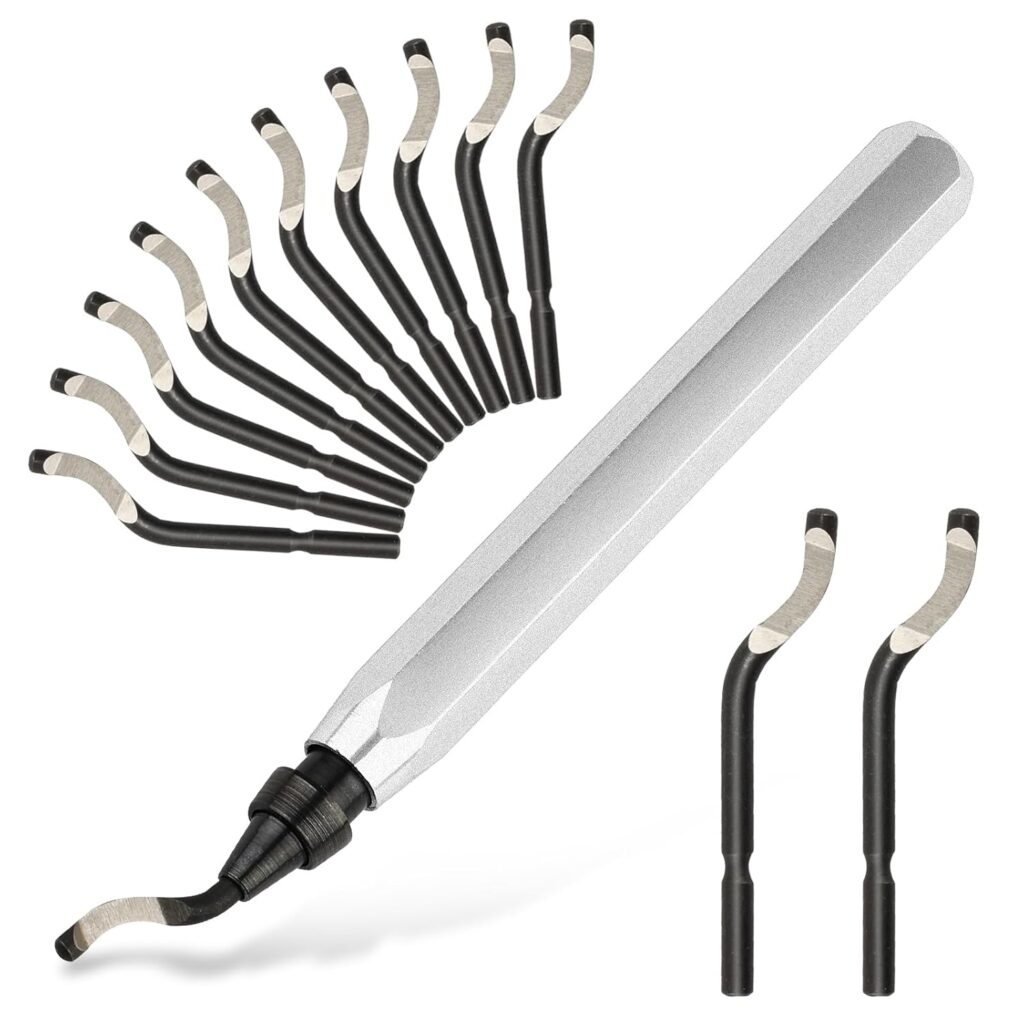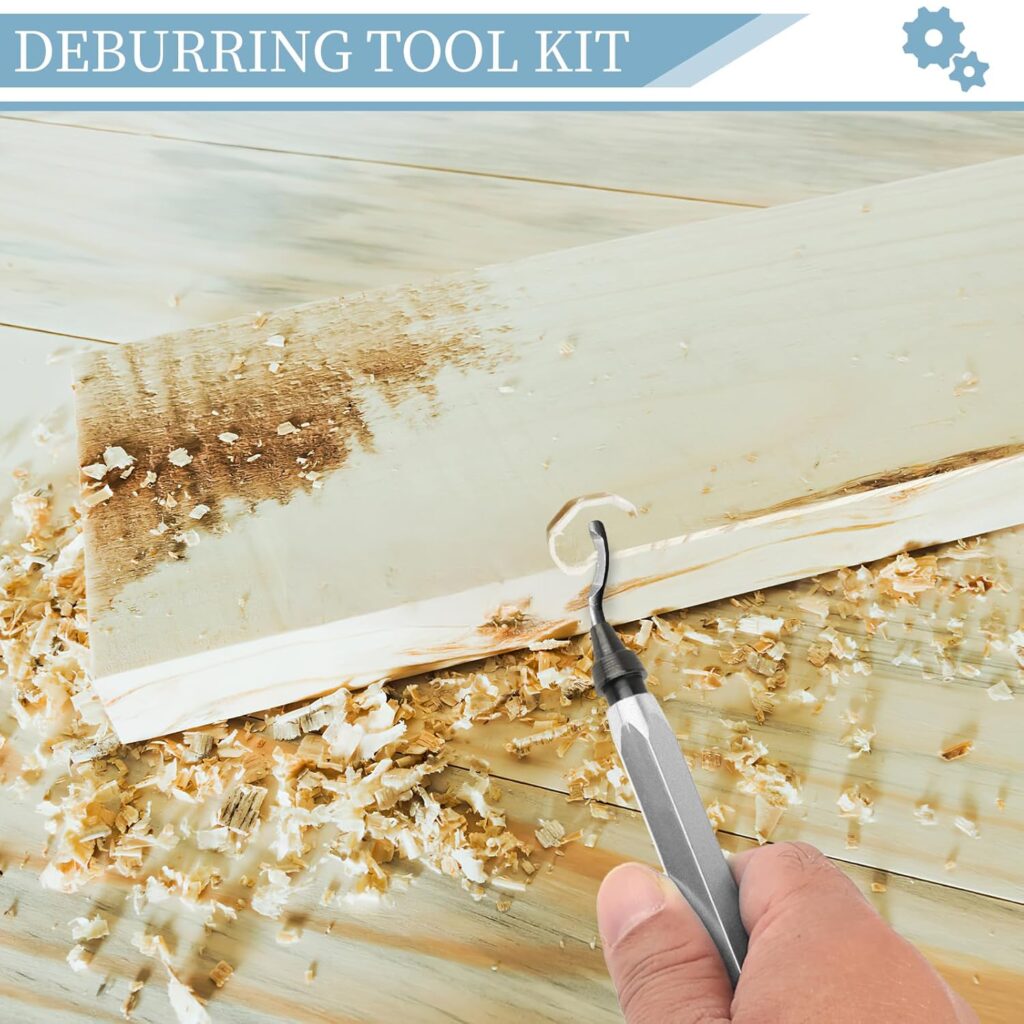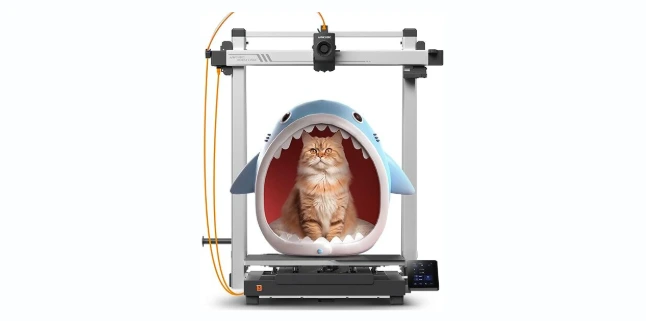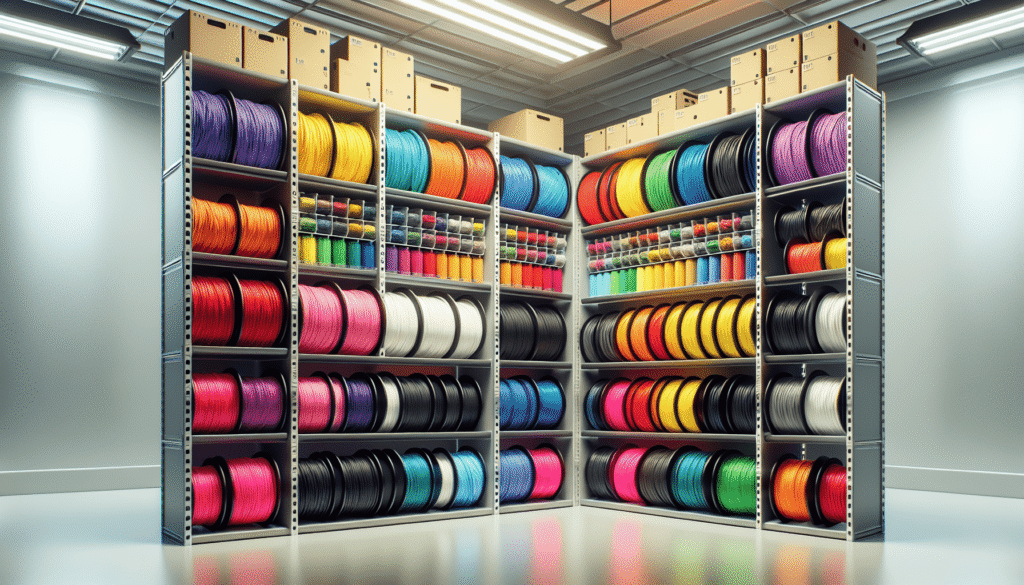Do you know that tiny, traitorous burr that waits until the moment I feel accomplished to snag my sweater or my skin?
Why I Reached for a Deburring Tool
I have a complicated relationship with edges. They pretend to be finished and then confess, under the slightest touch, that they are still clinging to little whiskers of metal or plastic. I used to ignore them, the way I ignore the blinking “check engine” light, until one day a rogue burr on a 3D-printed hinge pulled a thread from my favorite shirt. That was the final straw.
The oddly satisfying pursuit of smooth edges
There’s something meditative about cleaning up a part until it feels like silk. It’s simple, repetitive, and strangely gratifying—like scraping burnt cheese off a pan but without the disappointment. When I picked up the Deburring Tool with 12 High Speed Steel Blades (the blue-handled one that looks deceptively humble), I was looking for a better way to polish my pride, and my prints.
My benches and boxes of failed tools
Before this tool, my “de-burring system” involved a craft knife, some sandpaper that had seen better days, and a prayer. I hacked at edges until they surrendered, which they often didn’t. The results were inconsistent and occasionally lopsided. This tool was my attempt to replace the chaos with something purposeful and kind to both the material and my mood.
Deburring Tool with 12 High Speed Steel Blades, Deburring Tool 3D Printing, Deburring Tool for Metal, Resin, Copper, Plastic, PVC Pipes, 3D Printed Edges (1 Blue Handle)
What’s in the Box
When I opened the package, I found a single blue metal handle and a neat little set of twelve high speed steel blades that made me feel suddenly rich in potential. The handle is metal with a grippy feel and doesn’t play games with sweaty palms. The blades stash inside the handle, spring-loaded, which means no more rummaging through drawers or chasing loose steel around the floor.
The essentials laid out
The kit focuses on simplicity and longevity: a sturdy handle, a dozen high-strength blades, and a mechanism that actually feels engineered rather than guessed. It’s meant for metal, resin, copper, plastic, PVC pipes, and those finicky 3D-printed edges that seem specifically designed to test patience.
| Item | Description |
|---|---|
| Handle | Blue, metal body with a non-slip feel; comfortable in hand |
| Blades | 12 High Speed Steel (HSS) blades; durable and sharp |
| Mounting | Blades mount quickly; spring-loaded retention keeps them secure |
| Blade Motion | Blade rotates freely in the handle for smooth, controlled curves |
| Use Case | Metal, resin, copper, plastic, PVC pipes, 3D-printed edges |
| Operation | Manual deburring with 360° coverage around edges |
| Who it’s for | Professionals and hobbyists; industrial and DIY use |
First Impressions and Build Quality
Some tools arrive with the exhausted energy of something that already knows it’ll be replaced. This one did not. The metal handle felt substantial, the blue finish was cheerful without veering into toy territory, and the blades had that sharp, honest look I fear in kitchen knives and admire in shop tools.
The handle that feels like a handshake
I held the handle the way I hold a pen when I’m pretending to be thoughtful. The balance was right: not so heavy that it punished my wrist after a long afternoon, and not so light that it felt like a gimmick. The grippy texture meant I could apply steady pressure without bracing my elbows like a Victorian portrait sitter.
The blades that mean business
Each blade looked like it was cut from a whisper of steel, except it wasn’t a whisper; it was a promise. High Speed Steel is the practical kind of confidence—better edge retention, less chipping, and fewer moments where the tool decides it no longer believes in my project. Swapping the blades required no therapy or instruction manual. I pressed, turned, and heard the soft approval of the spring mechanism.
Setup and Use
I like tools that assume I can figure things out without a ceremony. This one has the good manners to be intuitive.
Installing a blade without drama
I pressed the spring-loaded tip at the end of the handle and slipped a blade into place. The blade seated with a decisive fit, and once it was locked in, it stayed put. No fiddling with screws. No tiny parts threatening to vanish.
My technique for smoother edges
I hold the tool like a fountain pen and present the blade to the edge at a slight angle—just shy of a kiss. The blade rotates freely, which means it follows the curve naturally. I use long, light strokes and work around the perimeter, 360° if necessary. For internal holes and channels, I use the same approach, letting the blade trace the shape like it’s writing a very short letter.
Safety, or how I keep my fingers
I learned quickly not to push down like I’m trying to prove something. The blade is sharp and doesn’t need my machismo. I keep a firm grip, watch where my other hand is lounging, and let the blade do the work. Eye protection, too, because burrs are tiny optimists that believe they can fly.
Performance Across Materials
I took the tool on a tour of my workbench materials like a judge on a talent show, except I’m not paid and there are no glittering finales—just clean edges and the absence of regret.
3D-printed parts: PLA, ABS, PETG, and the misbehaving few
PLA behaved like a quiet student who just needed encouragement. Edges around contours cleaned up beautifully, strings and wisps vanished, and support scars smoothed out without gouging layers. ABS felt denser and needed a slightly slower pass, but the results were tidy. PETG required a gentle touch to avoid catching; with patience and angle control, it shaped up too. For 3D printed edges, this tool has become my final step before assembly.
Metal edges: aluminum and mild steel
Aluminum burrs are frequent and unforgiving. A few passes along the edge, and the ragged fringe disappeared. On mild steel, I used a bit more pressure and let the blade do small, consistent cuts. The finish wasn’t mirror-smooth (I didn’t expect it to be), but it was clean and finger-safe.
Copper and PVC pipes: the plumbing section of my subconscious
Copper edges clean up beautifully. I ran the tool around the inside of a pipe after cutting it, appreciated the 360° coverage, and ended with a neat internal chamfer. PVC was even friendlier; it felt like sharpening a crayon. The tool cut uniformly without grabbing, and the edge softened in just a few passes. For quick on-site or at-home adjustments, it’s a no-brainer.
Resin casts: brittle but cooperative
Resin behaved like a delicate pastry. I used the lightest pressure and worked in short, careful segments. Overhangs and seams smoothed out without chipping, and the finish was consistent. I didn’t try to carve away large mistakes—this is for burrs, not remodeling—but for cleanup, it was precise and respectful.
Plastics that wander into my life
From acrylic sheets to random plastic housings, the blade took off the sharpness without frosting the edges or leaving tracks. On acrylic, I used especially slow strokes to avoid stress lines, and that made a big difference.
Precision and Finish Quality
A burr is small, but the insult it brings is oversized. The right tool makes it vanish like it was never there.
Clean edges without jagged afterthoughts
The free-rotating blade kept the motion smooth, which meant no chatter and no sudden bites. I could move around a curve like walking a dog that actually knows how to heel. Edges came out consistent in one or two passes, which spared me the monotonous sanding that used to end in boredom and uneven corners.
Accurate around features I care about
On 3D printed parts, I worried about thin walls and delicate text embossing. A light touch with the blade avoided that ugly peeled look. Holes emerged circular instead of lined with tiny whiskers. Internal corners needed a bit of patience, but with angle adjustments, I got there.
Speed and Efficiency
I love a tool that gives me time back without asking for a sacrifice. This one is fast in the way a good pen is fast—it moves at the speed of my decisions.
Time saved vs sandpaper and crafty improvisation
I used to spend minutes, sometimes an entire coffee, trying to coax an edge into compliance with sandpaper. Now I do it in seconds. The blade cuts cleanly, and the edge is neat after one or two passes. I still touch up certain surfaces with a fine abrasive if I’m feeling perfectionist, but the heavy lifting is over quickly.
One-handed ease is underrated
I keep one hand on the part and one on the handle, shifting position as needed without rearranging the entire workbench. That simplicity is surprisingly rare. I don’t have to clamp down every single time, although for tiny pieces, a clamp is still the safest move.
Ergonomics and Fatigue
If a tool hurts me, we’re not friends. Fortunately, this one minds its manners.
A grip I can keep all afternoon
The metal handle has a sure-footed feel without turning my palm into a chalkboard. The diameter is comfortable; I can hold it in a pencil grip for delicate work or a more assertive grip for pipe edges. After a long session, my hand was fine—an improvement over some oversized handles that demand wrist acrobatics.
Ambidextrous by default
I’m not left-handed, but I tried switching hands just to see. The tool didn’t care, which is a mark of thoughtful design. The blade rotation and handle shape work easily from either side.
Durability and Maintenance
I like tools that take the hint and continue. This one gives me that confidence.
Blade life that outlasts my impatience
High Speed Steel isn’t marketing fluff. It stays sharp through metal, plastic, and pipe jobs without turning into a butter knife. I rotate blades as needed and keep the spare set in the handle so I don’t have to rummage through drawers like a raccoon. If a blade eventually dulls, I replace it without performance drama.
Cleaning and storage
I wipe the blade with a cloth after each session, especially after metal work. Burr dust collects like glitter and likes to travel, so I flick it off and tuck the tool back with the spares sealed in the handle. No oil required, but a light wipe on the metal isn’t a bad idea if humidity is a regular guest.
Comparisons That Helped Me Decide
It’s only fair to compare the deburring tool to the stuff I used before, plus the tools I considered.
Craft knife vs this tool
A craft knife is sharp and versatile, but the angle is fixed by my hand and my optimism. It tends to catch in plastics and can skate across metals. This deburring tool gives me a smooth, rolling action that follows curves naturally. Fewer slips, better consistency, and no drama when working around holes or pipes.
Sandpaper and files
Sandpaper works, but it’s slow and messy, and I often round edges I meant to keep crisp. Files are better but bulky around tight corners. This tool slips into interior spaces easily and nibbles away excess material with more precision.
Countersink bits and pipe reamers
Countersinks are great, but they demand a drill or a handle and tend to go overboard if I sneeze. Pipe reamers are wonderful for plumbing specifically, but they don’t transition neatly into plastics or 3D prints. The deburring tool sits in the sweet spot—nimble across materials and shapes without needing a separate setup.
Pricier deburring tools
I’ve held industrial versions that cost more, and yes, they feel like they could survive a small war. This one, though, balances price and performance sensibly. The metal handle, the HSS blades, and the spring-loaded blade retention give it a premium feel without the premium invoice.
Where It Shines and Where It Doesn’t
I don’t expect one tool to replace everything. I expect it to be excellent at the thing it’s meant to do.
Strengths I noticed right away
- Quick, clean burr removal on a wide range of materials
- Free-rotating blade that glides along curves and inner edges
- Comfortable, non-slip metal handle
- Spring-loaded blade retention that keeps everything secure
- Compact, with spares stored in the handle for grab-and-go use
Limitations worth noting
- It’s not a carving tool; if I try to reshape a part, it will protest by catching
- Sharp internal corners can require patience and angle changes
- Very thick metal burrs still benefit from a file first, then this for finishing
- If I rush with soft plastics, I can gouge; a gentle touch is my friend
Tips, Tricks, and Small Joys
Some satisfaction in life comes from learning the tool’s preferences, the way you learn a friend’s coffee order or your cat’s inexplicable limits.
Light cuts win
I keep pressure low and let the sharpness do the work. If I hear a chatter or feel the blade skip, I adjust the angle and slow down. Fewer, lighter passes beat one heroic swipe every time.
Work with the geometry
When I go around a curve, I roll the handle into the curve so the blade follows the profile. For internal holes, I slip the blade into the opening and rotate the piece while maintaining a steady angle. On pipes, I start with the inside edge, then finish the outside, using the 360° coverage to keep things uniform.
For 3D prints: combine with smart settings
Even the best cleanup tool isn’t a cure for every printer sin. I reduce stringing with temperature and retraction settings, then use the deburring tool to remove the leftovers. For the elephant’s foot phenomenon, I use it to gently chamfer the bottom edge so parts fit properly without sanding marathons.
For 3D Printing: How I Use It Step by Step
I love 3D prints because they start as an idea and end as an object that still needs a little human affection.
Post-processing routine that saves me time
- Remove supports cleanly using pliers or a flush cutter.
- Run the deburring tool along edges and holes with light, consistent pressure.
- Tackle any stubborn seam lines with another pass at a steeper angle.
- Finish with a quick, optional polish from a Scotch-Brite pad if the print is for show. This replaces the sandpaper-first approach and makes the whole process feel dignified.
Fine details without damage
Printed text and thin walls are risky, but manageable. I keep the blade almost parallel to the surface and take the faintest shaving. If I can feel it more than see it, I’m doing it right.
Pipes: The Quick Chamfer I Actually Enjoy
I used to dread cleaning up pipe edges like I dread voicemail. This made it routine, in a good way.
Internal and external edges
On PVC and copper, I seat the blade inside the pipe and rotate the pipe with my other hand. The free-spinning blade keeps it smooth. Then I flip to the outside edge and even it out. It’s faster than any file and leaves a neat, functional chamfer that fits better and seats cleaner.
Trimming without flakes
PVC likes to shed little curls. I keep a rag handy to wipe them off after each pass, which keeps my work surface (and me) free of decorative confetti.
Metal Work: Clean Without the Fuss
Metal demands respect and predictable motion. This tool gives me both.
Sheet metal edges and holes
I trace along cut edges at a moderate angle. For drilled holes, I use short, circular motions, letting the blade follow the interior line. Burred holes stop grabbing screws, which gives me a smug sense of order.
Safe without overdoing it
On edges that will be visible, I keep my passes to a minimum to avoid rounding. On hidden brackets or quick prototypes, I allow myself an extra pass or two and enjoy the smoothness.
Resin and Crafts: Careful, but Worth It
Resin is the friend who wants to be invited but needs special arrangements.
Gentle, controlled passes
I use the lightest touch and short strokes. If the blade starts to dig, I back off and shift the angle. I’ve cleaned up casting lines and overflow without chipping. For polished resin surfaces, I sometimes switch to a micro-mesh pad after deburring for a consistent sheen.
Why the Spring-Loaded Design Matters
This isn’t just a pleasing mechanical click. It changes how I work.
Secure blades, zero wobble
The spring-loaded retention means the blade doesn’t loosen mid-job, which is the tool equivalent of a friend who shows up on time. It reduces chatter, and chatter is where scratches and frustration are born.
Quick swap during mixed-material sessions
If I dull a blade on metal, I can swap in a fresh one for plastic in seconds. There’s no pause that lets procrastination wander in and derail me.
The Learning Curve I Actually Liked
Some tools make me feel incompetent for an unreasonable amount of time. This one made me feel skilled in about five minutes.
The first hour: experiments and successes
I tried it on a PLA bracket first and felt the blade glide effortlessly. Then on a rough aluminum edge, which cleaned up without a tantrum. By the time I got to the PVC pipe, I was astonished at the clean chamfer from such a simple motion. The learning curve was less a curve and more a short curb I stepped over.
The Payoff in Real Projects
It’s one thing to admire a tool on principle; it’s another to notice it change how I work day to day.
3D printer upgrades that fit better
Holes for inserts and screws actually fit as intended once the burrs vanished. Snap-fit parts stopped squeaking like I was assembling a rubber band idea. It upgraded the whole assembly experience.
Home fixes without a whole workshop
The ability to deburr pipes, rough plastics, and metal brackets with one handheld tool meant I could actually finish something on a Saturday without a pilgrimage to the store. My weekend self is grateful.
Troubleshooting My Own Mistakes
I make them often enough that I’ve started to write them down.
If the blade catches
I’m pushing too hard or I’m at the wrong angle. I back off, start lighter, and approach the edge with the blade closer to parallel.
If the edge looks wavy
I’m taking off too much per pass. I reset, use lighter strokes, and let the tool skim, not chop.
If soft plastic frays
I slow down and use a newer blade. Sometimes, on very soft plastics, a quick post-pass with a fine abrasive pad helps seal the look.
Maintaining Momentum: Storage and Spares
The best compliment I can give this kit is that I keep it within reach.
Everything in one piece
The spares ride inside the handle, so I don’t go scavenger hunting mid-job. When a blade finally retires, I put the new one in and keep going. The blue handle stands out in my drawer like a lifeguard in summer.
Value for Money
There’s an honesty to a tool that earns its keep without excessive features or a lecture.
The price of consistency
For what it costs, the build quality and the dozen HSS blades feel like a steal. I don’t pay for complexity I won’t use. I pay for edges that stop biting me and projects that look finished, not almost-finished.
Who I Recommend It For
I tend to think everyone secretly wants smoother edges, but I’ll be specific.
Ideal users, based on my mishaps
- 3D printing enthusiasts who want clean, functional edges without chewing up layers
- Makers who work with mixed materials and don’t want a dedicated tool for each
- DIYers who cut copper or PVC occasionally and want a neat chamfer without specialized gear
- Hobbyists and professionals who appreciate a sharp, compact, reliable hand tool
A Practical Use-Case Table
Sometimes I like to see expectations on paper (or pixels) before I begin.
| Material / Task | Blade Feel | Passes Needed | Notes from My Bench |
|---|---|---|---|
| PLA 3D print edges | Very smooth | 1–2 | Ideal cleanup after support removal |
| ABS edges | Smooth, steady | 2–3 | Slightly slower, consistent finish |
| PETG edges | Can catch if rushed | 2–3 | Light pressure; adjust angle to avoid grabbing |
| Resin seam cleanup | Delicate | 2–4 | Short strokes; avoid heavy pressure |
| Aluminum sheet edge | Firm, controlled | 2–4 | No chatter with steady angle |
| Mild steel edge | Firm, slower | 3–5 | Use moderate pressure; finish is clean, not polished |
| Copper pipe chamfer | Smooth glide | 2–3 | Excellent internal and external chamfers |
| PVC pipe chamfer | Very smooth | 1–2 | Fast, uniform 360° coverage |
The “Why This One?” Moment
If the universe is generous, a tool feels right the second I use it. This one had that moment.
Features that made me certain
- The spring-loaded blade retention felt robust; no wobble, no hesitation
- The blue metal handle was grippy without being rough
- The blade rotation inside the handle made curves and holes effortless
- Twelve HSS blades meant I could work widely across materials without pausing
Real-World Scenarios I Keep Seeing
The value of a tool shows up in the quiet, repetitive scenarios that make up most of my projects.
After a long print finishes at midnight
I remove supports, sweep the tool along the edges, and the part looks like I planned it that way all along. If I need it to fit into another piece right then, I can make that happen without a trip to the garage for power tools.
When I cut a pipe too late in the weekend
Instead of leaving sharp PVC edges to the judgment of Monday, I clean them instantly and finish the job. It feels like a small victory that saves me from the “I’ll do it later” swamp.
When metal brackets arrive from a hardware store with little teeth
I refuse to install parts that threaten to behave like piranhas. A minute with the tool turns them into civilized components.
The Product Name I Actually Remember
In a sea of nearly identical gadgets, I remember this one because it works: Deburring Tool with 12 High Speed Steel Blades, Deburring Tool 3D Printing, Deburring Tool for Metal, Resin, Copper, Plastic, PVC Pipes, 3D Printed Edges (1 Blue Handle). That’s a long way of saying “the blue one that never lets me down.”
Little Habits That Improved My Results
Sometimes the difference between good and great is embarrassingly small.
The angle matters more than force
When I hold the blade just off perpendicular to the edge, it shaves instead of digs. I keep my wrist relaxed and let the blade swivel. That’s the secret to avoiding those occasional tiny gouges.
Rotate the work, not the wrist
For inside edges, rotating the piece while keeping a steady hand on the tool gives me more control and an even cut. It also saves me from doing uncomfortable wrist yoga.
Clean up as I go
I brush off burr curls every few passes. It keeps the workspace clear and lets me see whether I’ve taken enough material. It also prevents that unglamorous moment where a burr curl sticks to my sleeve and follows me into the rest of my day.
What I’d Change If I Could
I’m happy, but not incapable of wishful thinking.
Optional blade shapes
I’d enjoy a small selection of blade profiles for specialized jobs—something more aggressive for heavy steel, something extra-fine for acrylics. The included blades cover 95% of what I need, but imagination is free.
A small protective cap
A cap for the blade end would be a friendly addition for transport, especially when the tool is in a crowded drawer. Not a deal breaker; just a considerate accessory.
The Emotional Part of Finishing Edges
I realize how that sounds, but making things smoother changes how I feel about them.
Less snagging, more satisfaction
A burr-free part feels finished in the hand. It invites touch. It doesn’t fight back. That changes my relationship to the project—not just how it looks, but how inclined I am to keep making.
The quiet joy of dependable tools
This tool doesn’t need compliments. It just works. When I reach for it, I know what happens next, and in a life where so much is unpredictable, a good deburring pass is a small, reliable kindness.
Final Verdict
I keep this tool within arm’s reach, and it earns that spot every time. The metal handle feels right, the high speed steel blades stay sharp, and the spring-loaded retention makes swapping fast and secure. Whether I’m cleaning up 3D printed edges, knocking back the bite from a metal bracket, or chamfering PVC and copper pipes, it gives me smooth, consistent results with minimal effort. It’s friendly to both professionals and hobbyists, and it fits comfortably into the quiet rhythm of finishing work.
If you want a compact, reliable, and genuinely effective deburring tool with blades that last and a handle that won’t slip, this blue-handled kit is the one I trust. It turned my edges from guilty secrets into something I’m happy to hold, and that’s more than I expected from a simple, well-made piece of steel and sense.
Disclosure: As an Amazon Associate, I earn from qualifying purchases.
